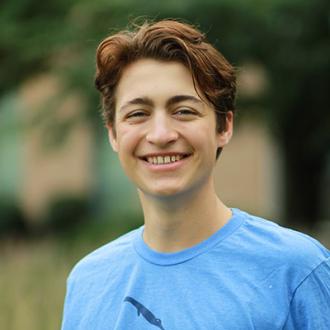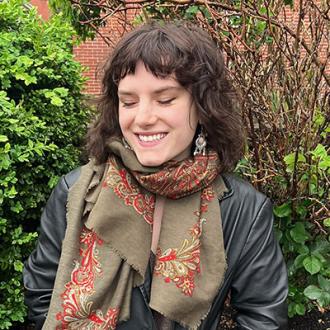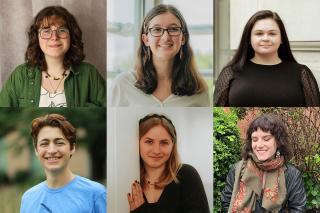Six graduating seniors have been selected for the prestigious Senior Scholar Award at Simmons University. Sponsored by the Provost’s Office and the Office of Research and Fellowships, the Senior Scholar Award recognizes outstanding scholarly research across different disciplinary fields.
This year’s Senior Scholar Award projects cover a range of topics, including Tourette Syndrome and Parkinson’s disease, gynecological healthcare, female liquor license holders in Revolutionary Boston, and the social influence of GIFs.
Congratulations to the 2025 award recipients! The award recipients will be presenting their projects at the annual Senior Scholar Award Showcase.
Introducing the 2025 Award Winners

Ginjer Doherty ’25
Major: Public Health, Africana Studies (minor)
Faculty Mentor: Kristen Brewer
Project: Queer Assigned Female At Birth (AFAB) Experiences with Gynecological Care
Research focused on the experiences of queer assigned female at birth (AFAB) individuals is important as it is historically, and currently, under researched; systemic changes to the treatment of this community are needed to improve care by medical professionals. Individuals in this community often feel that they are not conforming to “accepted” sexual behaviours of young females; this feeling differentiates the needs of this community’s gynecological care needs and contributes to inequities in care (Scherzer, 2000). Additionally, members of this community often feel they receive a substandard level of care and overall systemic barriers to the healthcare system exist (Smith et al., 2017).
This study aims to provide insights into healthcare experiences of AFAB individuals who participate in acts of physical intimacy with other AFAB people. Specifically, their experiences related to their experiences with gynecological care providers, or other equivalently servicing providers. This study used qualitative methods for data collection by conducting one-on-one interviews with participants. Topics addressed from the semi-structured interview guide included: STD/STI testing, birth control, and routine gynecological care. Additional follow-up questions were asked, focusing on the intersection between a person’s experiences with self identity, experiences with coming out, and current-day comfortability with their identity and how this impacts the experiences receiving gynecological care and treatment.
Fifteen interviews were conducted on individuals with sexuality-based identities including bisexual, queer, lesbian, and asexual as well as gender-based identities including woman, agender, nonbinary, lesbian, and butch. Interviews were recorded and transcribed for analysis of emerging themes.
About Doherty
Ginjer Doherty is a senior studying public health with an Africana studies minor. She is interested in health inequities, social epidemiology, and enjoys doing qualitative research, which can be seen in her thesis project: Doherty was accepted to Boston University’s School of Public Health to earn her MPH and plans on attending with a double concentration in epidemiology and biostatistics and community assessment, program design, implementation, and evaluation. Doherty was raised on the New Jersey shore, has been vegetarian her entire life, and has a pet gecko living in Boston with her.

Aviva Foster ’25
Major: Psychology
Mentor: Lauren Trichtinger
Project: The Social Influence of GIFs: How GIFs Shape Emotional Perception and Empathy
Key Contributors: Dr. Monica Riordan (Chatham University)
Digital communication increasingly relies on visual cues such as GIFs, yet their impact on emotional perception and social interaction remains underexplored. This research evaluates how GIFs influence emotionality, ambiguity, and perceived need to elicit empathy.
Drawing from the EASI (Emotions as Social Information) model, this investigation includes two experiments involving GIFs in text-based interactions. The first study examines whether GIFs enhance the perceived intensity of emotions and unambiguity of texts, compared to text-only messages. Participants were presented with examples of positive and negative text messages from a friend, either with a GIF or without, and rated how clear and emotional they perceived the message to be. A t-test was conducted, finding that text messages with GIFs had a statistically significant increase in perceived emotionality. There was no significant effect on dis/ambiguity.
The second study explores whether GIFs amplify participants' emotional reactions and perceptions of a sender’s need when requesting help, thereby increasing empathy. It also investigates whether this effect is influenced by the perceived appropriateness of a message. A mediation-moderation model was used to analyze the data, which found that GIFs did not make a significant difference in participants’ empathy.
This research contributes to the communication and psychology fields by offering empirical evidence regarding GIFs’ function as digital emotional cues. Findings may inform social media platforms, marketing strategies, and interpersonal communication, highlighting and changing our understanding of the role of GIFs in fostering empathy and social connection. More broadly, this study underscores the evolving nature of digital expression and its implications for human interaction across disciplines.
About Foster
Aviva Foster is a senior majoring in psychology and minoring in both data science and analytics and philosophy. She is interested in many subject areas, encompassing both narrow and interdisciplinary fields of study, especially the intersections of psychology/data science and data science/ethics. For several years, she has worked as a research assistant with Dr. Nanette Veilleux at Simmons on “Prosody and Meaning,” a linguistics-focused research project; she also previously worked with the Quantitative Psychopathology Lab at Boston University (in conjunction with Dr. Lauren Trichtinger at Simmons), and currently has a psychology fieldwork internship position with the HEALthy Brain and Child Development (HBCD) research study at Boston Children’s Hospital. After graduating, Foster is planning to pursue a master’s degree in data science.

CJ Haggard ’25
Major: History
Mentor: Steve Berry
Project: “To Indulge Her with a License”: Female Liquor License Holders in Revolutionary Boston
This thesis explores the lives of the women licensed by the town of Boston to sell liquor (or “rum and other spirits”) in the decade preceding the American Revolution, from approximately 1760 to 1773. This exploration occurs through close examination of extant license petitions, lists of licensed persons, town records, probate records, and newspaper advertisements in order to create a clearer picture of the extent and nature of this category of women’s work in colonial Boston.
The information provided by these documents, particularly by the lists of licensed persons compiled annually by the Boston Selectmen, indicate that this profession was much more widespread among women than originally thought and participation was remarkably balanced among men and women.
In-depth analysis of the records these women left behind paints a new and vibrant picture of the social, legal, and economic realities of their lives. From spousal death to physical disability, each woman experienced unique circumstances that led her to apply for a license, and each had varying levels of success with their endeavors. Through sparse details in petitions, estate data in probate records, and town records, the stories of these women begin to come into view. Despite the fact that many aspects of their lives are lost to history due to gaps in extant documents, this paper hopes to contribute to the valuable endeavor of interpreting and preserving the history of ordinary women.
About Haggard
CJ Haggard is an aspiring archivist majoring in history with a concentration in public history. Originally from Hiram, Georgia, Haggard has thoroughly enjoyed her time at Simmons and in Boston. She serves as co-president of Simmons’ competitive Model United Nations team, an activity she has participated in since her freshman year of high school, and was able to study history and Archaeology on a semester abroad at University College Dublin in Spring 2024. Haggard’s passions include the history of women and gender, the American Revolution, and historical fiction as public history. Haggard currently works as a Library Assistant at the Massachusetts Historical Society and is planning to enter the field of archives and libraries after completing a Masters of Library and Information Science at Valdosta State University. This thesis has truly been a passion project for Haggard, and she hopes her joy for the subject comes across in her scholarship.

Theo Hatfield ’25
Major: Biochemistry
Mentor: Seth Johnson
Project: Exploration of Non-Autophagic roles of Atg8a in Drosophila Behavioral Development
Tourette Syndrome (TS) is a common neurological condition, characterized primarily by involuntary behaviors known as tics. The condition is highly heritable, however, its underlying biology and genetics are complex and relatively unknown. One gene, GABARAP, shows expression negatively correlated with tic severity in some human TS patients.
In this project, we aim to contribute to present knowledge of TS-like behavioral development using the fruit fly (Drosophila melanogaster). Given Drosophila shares roughly 75% of the human genome, it is an advantageous model organism. We leveraged this high degree of similarity to explore how GABARAP may influence TS-like behavioral development. We have modeled GABARAP's decreased expression, utilizing RNAi to knock down the gene's well-conserved Drosophila ortholog, Atg8a. Our results demonstrate that Atg8a deficit produces behaviors in D. melanogaster consistent with those seen in other TS models and TS patients such as compulsive grooming and learning deficit. This indicates that Atg8a aids in regulating compulsive behavior and learning ability implying that GABARAP may impact behavior similarly in humans. However, how the Atg8a deficit contributes to behavioral development is still unknown.
Moving forward, we plan to elucidate the mechanisms disrupted by Atg8a knockdown that may be contributing to atypical behavior. Not only will this broaden our understanding of Atg8a as a behavioral regulator, but our findings may give some insight into its human counterpart’s role in TS development. In understanding this, we can contribute more broadly to the knowledge of TS pathology hopefully aiding in the identification of improved treatment strategies down the road.
About Hatfield
Theo Hatfield is a senior majoring in biochemistry with a minor in biostatistics. After graduation, Hatfield intends to pursue graduate studies in microbiology and immunology with the end goal being to get a PhD in this field. Overall, he aims to enter a career as a researcher and educator in this subfield, specifically working to engage non-scientific communities more with biology.

Lili Malatinszky ’25
Major: Biology
Mentor: Eric Luth
Project: Generating a Split Fluorescent-Tagged Spastin/SPAS-1 to Explore Spastin Removal's Neuroprotective Effects in Parkinson's Disease Pathology
Parkinson’s disease (PD) is one of the most common neurodegenerative diseases and, while we have a solid understanding of the symptoms of the disease, its cause is much less understood. PD is considered a synucleinopathy, meaning that the abnormal aggregation of the protein, ⍺-synuclein, results in dopamine neurodegeneration with age– a hallmark of the disease.
There is also preliminary data suggesting that the inhibition of the protein, spastin, is neuroprotective. Spastin is a microtubule-severing protein involved in several vital cell functions, but when inhibited in a human cell culture PD model, it decreased ⍺-synuclein aggregation and increased cell survival; this inhibition of spastin throughout the body seems to be neuroprotective in our C. elegans animal model of PD as well. Still, we do not understand why the inhibition of spastin, this otherwise essential microtubule-severing protein, prevents neurodegeneration– nor do we have a model system that allows us to explore this.
Our immediate goal is to generate a model that will allow us to take a closer look at spastin under ⍺-synuclein’s influence. We are addressing this using CRISPR/Cas9 genomic editing to insert a split fluorescent tag into the C. elegans spastin homolog, SPAS-1, increasing the variability of spastin visualization. In tandem with this, we are inserting the other portion of the split fluorescent tag to a motor neuron promoter and allowing the two pieces of the split fluorescent tag to associate, making SPAS-1 fluorescently visible only in motor neurons. This sets the stage for further exploration of these proteins’ relationship in order to better characterize the mechanisms of PD pathology, and hopefully identify and improve drug targets in the long run.
About Malatinszky
Lili Malatinszky is a senior majoring in biology with a minor in chemistry. She has spent the last two years in Dr. Luth’s research lab on campus while working toward her long-term career goal of becoming a physician associate. Malatinszky enjoys being involved in the Simmons Biology Department in a variety of ways, including her role in the biology liaison and as a biology tutor, all in an effort to bring together a community based in a love and fascination for studying biology. The driving force of Malatinszky’s scholarly and career goals boils down to her passion for increasing the public’s access to information and, therefore, their access to healthcare — she carries this principle throughout her work both in the lab and otherwise.

Grace Walters ’25
Major: Art, Education (minor), Literature (minor)
Mentor: Daren Graves
Project: Rooted and Rising: A Holistic and Accessible Approach to Early Childhood Education
Reggio Emilia’s emphasis on sensory-rich experiences through art, music, and nature provides a vital counterbalance to the screen-dominated childhoods of the 21st century. As an ""atelierista"" — an early childhood expressive arts specialist—at a Reggio Emilia-inspired preschool in Waltham, I am currently exploring how emergent curriculum supports children’s cognitive, emotional, and social development through child-centered, hands-on learning. Emergent curriculum, a core tenet of Reggio Emilia, is a flexible, responsive approach that builds on children's interests and real-life experiences. By prioritizing creativity, problem-solving, and collaboration, it nurtures critical thinking and engagement. Within this framework, the arts play a foundational role. The “Hundred Languages of Children” philosophy underscores how open-ended materials — such as clay, paint, recycled materials, and natural elements — serve as tools for communication and self-expression. Emergent art projects, from seasonal murals to collaborative sculptures, strengthen fine motor skills and spatial awareness while fostering aesthetic appreciation.
Music, another key component, supports auditory skills, language development, and emotional regulation. Through vocal play, rhythm exploration, and child-led instrument-making, children develop self-expression and social bonds. Similarly, nature serves as an immersive classroom and offers sensory-rich opportunities for ecological literacy, physical development, and mental well-being. Incorporating natural materials into the classroom and embracing outdoor learning counteracts the adverse effects of excessive screen time, thus promoting deep engagement with peers and the environment.
This research also considers challenges such as balancing screen-free education with societal pressures for early tech literacy; it addresses resource constraints and ensures accessibility in diverse educational settings. Through case studies and literature, this paper examines the relevance of Reggio Emilia in modern early childhood education and its potential to shape holistic, developmentally appropriate learning experiences.
About Walters
Grace Walters is a senior majoring in art with a minor in education and literature. Passionate about early childhood education, she is dedicated to exploring and implementing innovative, child-led learning approaches, particularly the Reggio Emilia philosophy. She believes that all children deserve access to rich, meaningful, and developmentally appropriate learning experiences, regardless of socioeconomic background, learning style, or ability. In addition to her academic and teaching work, Walters is an artist specializing in ceramics, fiber arts, and photography. She sees art as a powerful tool for communication and self-expression, particularly for young children who may not yet have the words to articulate their thoughts. Upon graduating, she plans to continue her work in early childhood education while exploring new ways to make innovative pedagogies more accessible to all children.

